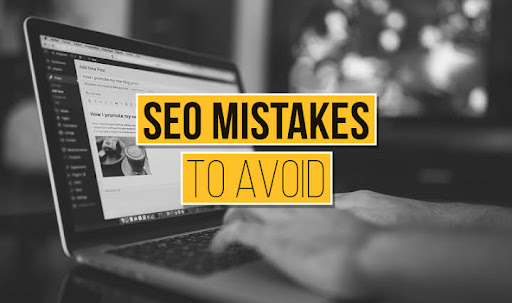Mar 06, 2025
SEO Mistakes to Avoid That Are Hurting Your Website

Search engine optimization (SEO) is one of the most powerful tools for long-term online growth. But here’s the truth: you don’t just need to do SEO—you need to do it right. Because even the best strategies won’t work if they’re built on a foundation of common SEO mistakes.
Many websites unknowingly fall into bad SEO practices that prevent them from ranking, limit traffic, and affect conversions. Whether you’re a startup, an established business, or a growing brand, identifying these pitfalls is critical.
Let’s dive into the most damaging SEO mistakes to avoid and what to do instead to ensure your website stays competitive in 2025 and beyond.
1. Ignoring Search Intent
Search engines are smart, but they’re still focused on one thing: delivering the most relevant result based on a user’s query.
Mistake: Optimizing for keywords without aligning with what the user is actually searching for.
Why It Matters: If your content doesn’t match the intent behind the search—whether it's informational, navigational, or transactional—you won’t convert. Worse, Google will push you down in rankings.
Fix: Always align your content format with the intent.
- For informational queries: Use blogs or how-to guides.
- For transactional queries: Use landing pages, product pages, or service descriptions. Use tools like SEMrush, Ahrefs, or Google Search Console to analyze what searchers expect.
2. Overusing Keywords (a.k.a. Keyword Stuffing)
Common SEO issue: Using a keyword repeatedly in your content in an unnatural way.
This outdated tactic not only makes your content harder to read but also risks penalties from search engines. Google can now detect when content is written for bots—not people.
Fix: Focus on semantic SEO. Instead of repeating the same keyword, include variations and related terms. Use tools like Clearscope or Surfer SEO to maintain keyword density without overdoing it.
3. Neglecting Technical SEO
Even the most beautifully written content can fail if your website has technical issues.
Mistake: Ignoring factors like page speed, crawlability, indexing errors, mobile responsiveness, and Core Web Vitals.
Why It Hurts: Search engines prioritize fast, accessible, and error-free websites. Technical SEO forms the foundation of your entire SEO strategy.
Fix: Run a monthly technical SEO audit. Key things to check:
- Use Google PageSpeed Insights and Lighthouse.
- Ensure mobile optimization.
- Fix broken links and duplicate content.
- Submit XML sitemaps and improve internal linking.
Tip: Technical SEO isn’t a one-time job. It’s an ongoing process that must evolve with your website.
4. Publishing Thin or Low-Quality Content
Google doesn’t want more content—it wants better content.
Mistake: Writing short or shallow content that doesn't deliver value.
Why It Hurts: Thin content fails to answer user questions or solve their problems. It increases bounce rates and lowers your site’s authority in Google's eyes.
Fix: Go deep. Cover topics comprehensively. Include relevant data, visuals, real-life examples, FAQs, and structure your content for readability.
Ask: Would I stay on this page if I landed on it from Google?
5. Not Optimizing for Mobile
Bad SEO practice: Focusing on the desktop version of your site while ignoring mobile usability.
Why It’s Critical: Google uses mobile-first indexing, which means your mobile version is prioritized for rankings.
Fix:
- Use responsive design.
- Avoid small font sizes or clickable elements that are too close together.
- Optimize images for faster loading.
- Test your mobile performance with Google’s Mobile-Friendly Test.
6. Weak or Broken Internal Linking
Internal linking helps Google understand your site structure—and it helps users navigate easily.
Mistake: Either not linking to other pages within your site, or doing it excessively without strategy.
Why It Hurts: Poor internal linking leads to orphaned pages, reduces crawl efficiency, and weakens topic authority.
Fix:
- Use contextual, relevant links between related blog posts and service pages.
- Limit links to 3–5 per 1000 words unless necessary.
- Use natural, descriptive anchor text.
7. Duplicate Content and Cannibalization
Mistake: Publishing identical or very similar content across multiple pages—or targeting the same keyword on multiple pages.
Why It’s a Problem: Google may struggle to decide which page to rank, leading to neither of them performing well.
Fix:
- Consolidate duplicate content into one page.
- Use canonical tags where needed.
- Avoid targeting the same keyword cluster on multiple URLs.
8. Poor Meta Tags and Title Optimization
Your page title and meta description are the first things users and search engines see.
Mistake: Using duplicate meta titles, leaving them blank, or writing unengaging, non-optimized copy.
Why It Hurts: Meta tags influence click-through rate (CTR) and relevance. Poor tags = lower traffic.
Fix:
- Keep titles under 60 characters and descriptions under 155.
- Include your primary keyword naturally.
- Make them compelling — think of them as ad copy.
9. Not Updating or Refreshing Old Content
Even evergreen content needs a tune-up from time to time.
Mistake: Creating content once and never revisiting it.
Why It Hurts: Stats become outdated, links break, competitors catch up. Google prefers fresh content that reflects the latest info.
Fix:
- Conduct a content audit every 3–6 months.
- Update outdated facts, improve structure, add new insights.
- Reindex the page via Search Console after updates.
10. Treating SEO as a Set-and-Forget Task
SEO is not a project. It's a long-term process.
Mistake: Doing a one-time optimization and expecting results to last forever.
Why It Hurts: Algorithms change, competitors evolve, and user behavior shifts.
Fix:
- Monitor rankings and traffic consistently.
- Adapt your content and strategy based on analytics and search trends.
- Treat SEO like you treat product development or customer service — a core business function.
Final Thoughts: Build Growth by Avoiding These SEO Pitfalls
The costliest SEO mistakes aren’t always obvious—they’re the slow leaks that drain your potential over time.
At Uprankx, we believe great SEO is just as much about what you avoid as what you do. By staying away from these common SEO issues and outdated techniques, you protect your brand’s visibility, credibility, and revenue.




